I started my own regular home yoga practice back in January 2017. My relationship with my yoga self-practice has changed a lot during those 2,5 years of practice. At times my yoga self-practice has added such a rewarding and fulfilling feeling to my life. At other times it has been something I did out of a feeling of guilt or duty because I came to expect too much of myself and of my home yoga practice.
I’ve realised the impact my home yoga practice has had on my life all depended on the mindset I built around it. So today I’m sharing what has helped me build a positive mindset around my home yoga practice to make it feel fulfilling and impactful – even on off days. I hope this post will bring you value and lots of rewarding practices in the future! x
Want a fulfilling yoga self-practice at home but unsure where to even start?
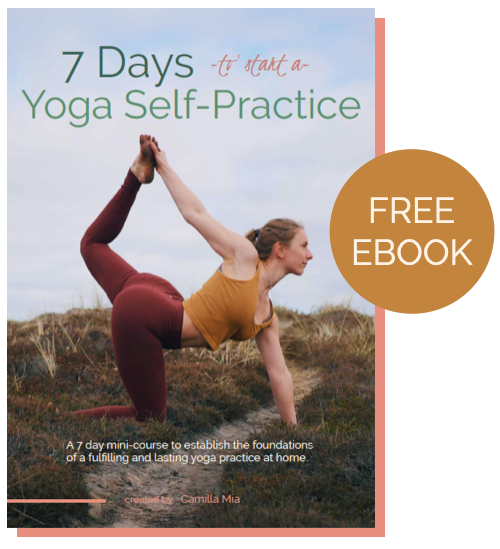
Get the mini-course 7 Days to Start a Yoga Self-Practice to establish a lasting and inspiring independent yoga practice at home!
In 7 days and 7 challenges, the mini-course takes you through how to establish a yoga self-practice step-by-step.
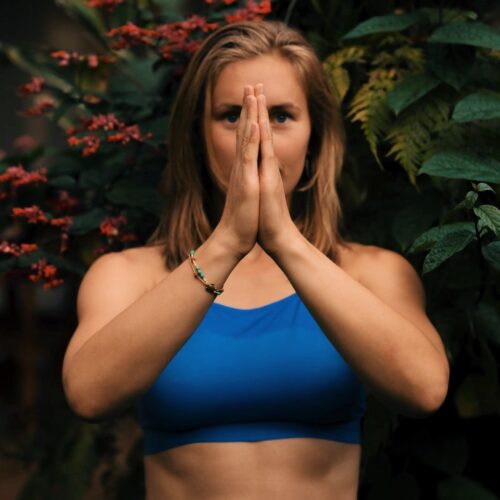
12 ways to build a positive mindset about your yoga self-practice
START SMALL
This one is especially important if you’re just getting started with your home yoga practice or if you’ve been away from it for a while – start small. Start making time for small snippets of home practice time during your week.
Once that becomes manageable you can start to slowly add a little more time as weeks go by to have longer and longer practice sessions. Remember that it’s tough work to form a new habit! So don’t expect to be doing 60 minute practices several times a week right of the bat (or at all).
5 MINUTES IS ENOUGH
Knowing that 5 minutes is enough has made my yoga practice so much more enjoyable. Keeping that in mind has helped me feel a sense of accomplishment even if I only manage to squeeze in 5 mins of practice time throughout my week. Anything beyond 5 minutes is great too! But don’t be hard on yourself if you don’t manage to do a full practice (or even practice at all) some weeks.
Stick to the mindset that you’re coming to your mat out of a love for yourself and a wish to do something good for yourself. If you start building up all these rules and expectations that your yoga self-practice should last a certain amount of time every single time you practice, it will start to feel like an obligation and a duty instead of feeling like your time to tune in and find contentment. Try to step onto your mat from a place of self-compassion instead of a place of guilt and obligation.
How 8 minutes of practice can look
The video below shows one of my self-practice sessions. I only practiced for 8 minutes, but I managed to build up a sweat and sit down and tune into my breath. Even though my practice was short, it left me feeling so much better than before I stepped on my mat.
I wanted to share this to show how much of a difference just 5 minutes of practice can makes! It doesn’t even have to be as dynamic a practice as that. Sometimes a few gentle movements and stretches or simply 5 minutes of mindful breathing can leave you feeling so much better and ready to take on the day. Over the course of months or even years those 5 minutes you squeezed in every week add up and can have life changing effects on your overall well-being and contentment in your daily life.
MAKE THE DECISIONS IN ADVANCE
If you find it difficult to motivate yourself to get on your mat, take as many decisions out of the equation as possible. In my experience, making the decision to practice as manageable and effortless as possible helps you form the habit of having a regular home yoga practice.
What I mean by that is:
Lay out your yoga clothes the night before if you practice in the morning. Expect no more than 5 minutes of practice from yourself until that becomes manageable. Free up a specific time in your schedule for your practice. Prepare your practice inspiration source in advance – whether that means choosing which online yoga video to follow, choosing a yoga sequence (e.g. sun salutations) to do or the focus of your practice in advance. If you know that you’re the type of person who needs a plan, checklist, etc., before you practice, have that ready in advance!
Do all of those little things that you need to do before you can step onto your mat and practice, in advance. By doing that you’re taking as much of the decision making out of the equation as possible beforehand. So that once it’s practice time, you can just jump right into it without dealing with a bunch of obstacles that need to be addressed before you can actually get into your practice. Because on days where we have limited time or energy, (at least for me) those obstacles can become excuses not to practice.
YOUR PRACTICE – YOUR RULES
Your practice, your rules. Knowing that your practice doesn’t have to look a certain way to be a “proper” yoga practice is hugely liberating. Your practice doesn’t not have to look anything like a “real” yoga class in a studio.
It can be just 5 minutes of stretches and wiggles some days. It can be disrupted with lots of trial and error other days. It can simply be a couple of minutes of mindful breathing or meditation other days.
Your practice can also be flowy and structured like a studio yoga class sometimes. Just know, that if you come to expect it to be that way every single yoga self-practice you are putting a lot of pressure and expectation on your yoga practice and limiting yourself from all the self-exploration and playfulness that comes from having no strict rules or guidelines to follow. It’s incredibly liberating to unleash yourself from your expectations and let your mood and your body lead your practice.
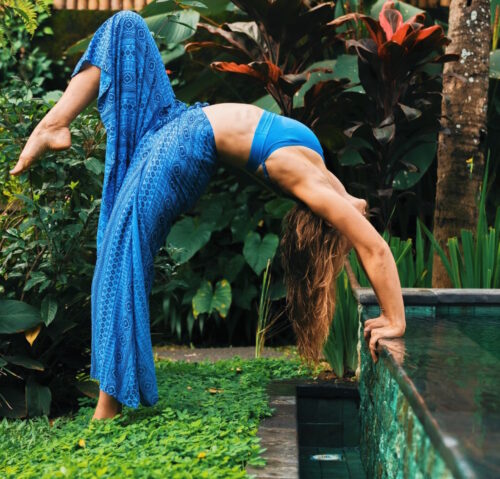
LISTEN IN
This is a big one! Learning to listen in can be super hard in the beginning but it’s such a valuable thing to practice. You’ll gain so much self-awareness and self-knowledge from doing so. And you’ll learn to respect your own boundaries and limitations more by becoming more clear on how they might change from day to day. Ask yourself these questions to get started tuning deeper into yourself:
- What is my energy level like today?
- What does my mental/emotional state feel like?
- How does my body feel right in this moment?
- Are there any areas of my body, where I feel a sense of unease or tension?
Try to match your home practice on any given day to the state you arrive on your mat in. E.g. don’t feel like you have to do a super dynamic and sweaty practice on the days where you are exhausted and in need of a calmer more restorative practice. Always, always listen in, so you can honour the state you’re in and neither push yourself too hard nor too little.
Sometimes your (mental/physical) state can change during your practice too. So be present and keep tuning in to yourself. Let your breath and your body lead the way and decide the pace.
KNOW YOUR LIMITS
Know your limits. This is such an essential one! But it’s also a tough one to know in the beginning. Because how do you distinguish pain from a sensation of intensity (which doesn’t necessarily have to be a bad thing)? With practice you will know the difference and become much more aware of your own limits and boundaries.
For starters, know that if you notice any pain or pinching sensations in your body during your practice, back out of it immediately. Either by backing a little out of the depth of the pose or by moving out of the pose completely, if you’re still feeling pain.
Nothing good ever comes from pushing through pain in our yoga practice. That is your body telling you to stop what you’re doing because something isn’t right. Of course, there’s a difference between feeling intensity in your muscles and feeling outright pain.
Avoid pain or pinching sensations
In general, if you’re feeling a lot of pinching or painful sensation in your joints (bones, ligaments, and tendons), that’s a bad sign. Stretching and strengthening sensations can sometimes feel quite intense. In general, the intensity coming from such sensations should be felt in muscle tissue, not in joint tissues.
Bottom line: pushing through pain is never a good idea. Find an alternative variation of the pose you’re doing or back out of it completely. Slowly you’ll start to know the poses and movements, which are sustainable and good for your body and which are not serving you.
You are definitely not “bad” at yoga for not reaching the deepest expressions of the poses – some poses are actually only available for people with certain type of bone structures, so don’t compare yourself to others. Just do your own thing 😉 and honour your own limits.
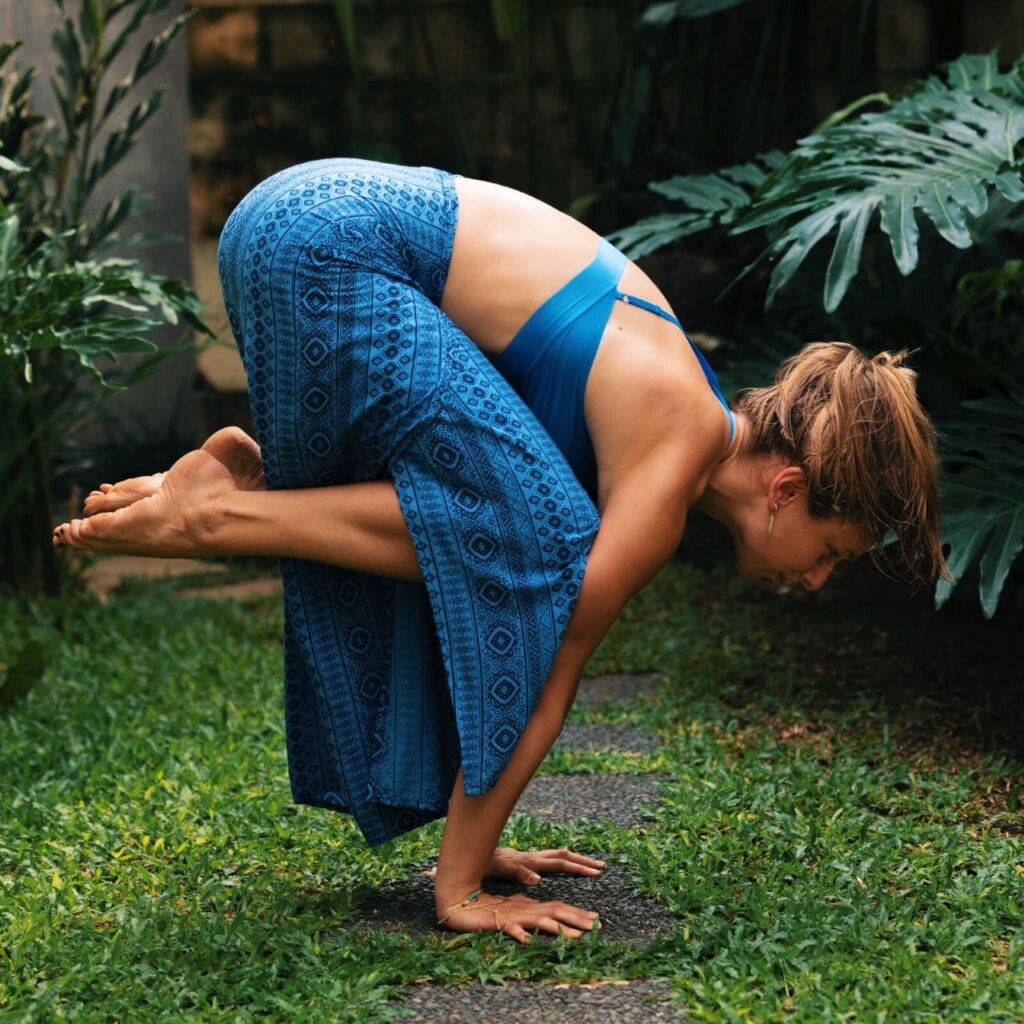
CUT YOURSELF SOME SLACK
Perhaps you skipped a practice. Or several.
Perhaps your practice didn’t feel the way you wanted it to or you didn’t go as deeply into the poses as you’d hoped for (or as deep as you’ve come to expect from yourself).
What really helped me build a better relationship with my yoga practice and myself in general was to become aware of those negative feelings I would sometimes have surrounding my practice (and my life). As soon as I catch myself feeling guilty for not practicing or feeling disappointed in my own capabilities during a practice because I had too high expectations of myself, I remind myself that those thoughts really aren’t serving me. Those negative thoughts are neither helpful nor productive.
How to avoid feeling guilty for neglecting your yoga self-practice
If you do feel guilty for skipping too many practices, see if you can turn that around by taking action to change it. Squeeze a new practice into your schedule or step onto your mats for just 5 minutes right away! Knowing that you took steps to get back on track again is so much more productive and meaningful than dwelling on your negative thoughts and emotions.
How to avoid disappointment in your yoga self-practice
If you do feel disappointed in yourself because your practice didn’t look the way you expected it to, see if you can adjust your expectations surrounding your practice to serve you better. Allow yourself to start fresh each practice and allow your strength, flexibility and balance to vary from day to day – because it naturally does!
The way your practice feels depends on all sorts of things like how well rested you are, what you’ve eaten lately, your stress levels, time of day, how well you’ve recovered since last movement session, aso.
If you still find yourself attaching expectations to your practice, which you fail to meet, make yourself name 5 things you’re grateful for in regards to your yoga practice.
For me, I remind myself how thankful and privileged I am to be able to move every day, that my body is capable of so many things, that I have the discipline to step on my mat regularly, and remembering how much my yoga practice has improved my overall well-being and contentment in life reminds me how silly I’m being for feeling disappointed in the way my practice looks.
Besides it’s super counterproductive to attach to how our practice should look when practicing non-attachment is actually the key to finding more contentment and joy in life. So practice non-attachment, practice letting go of your expectations so that you can fully enjoy and immerse yourself in your yoga practice.
EMBRACE THE SUCK
How we react to challenging, intense, or advanced postures in our yoga practice will tell us a lot about how we react to challenges out in the real world too. Getting comfortable with the uncomfortable is an incredible thing to practice.
The yoga mat, is in my opinion, one of the best places to practice exactly that. It will not only make you much better at your yoga practice and help you make faster progress on your mat, it will also make you better at life in general!
What stepping out of our comfort zone teaches us
So when you feel like you suck at certain poses or you find yourself falling out of balancing postures or shaking in hard postures – remind yourself that doing stuff that you find hard means that you’re stepping out of your comfort zone.
Notice how you react in situations in your yoga practice, which feel uncomfortable. Can you start to laugh at yourself when you’re struggling instead of beating yourself up over it? Can you start to pick yourself up and try again when you want to quit instead?
Embracing the hard things and trying to find some kind of contentment even when you’re struggling is a transformative shift in mindset, which will not only improve your relationship with your yoga practice, it will improve your life!
GET CREATIVE
Getting creative will make practicing possible even when life tries as hard as it can to get in the way of your yoga practice.
Impossible for you to practice because you never have any alone time? Do some light stretches while you’re watching tv with your friends/partner/family.
Too many house chores boggling you down? Do some breathing exercises while you do the dishes or practice being fully present and mindful while you’re cooking.
Your practice doesn’t need to look a certain way for you to benefit from it. Thankfully, it’s your practice so you get to decide what your yoga practice looks like. In the end, a bit of yoga and mindfulness sprinkled in throughout your day is so much better than not practicing at all.
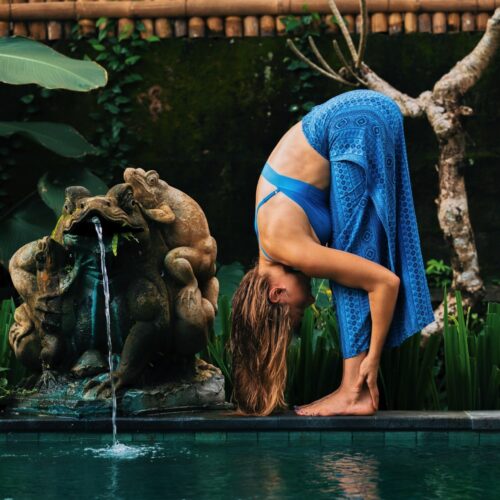
SET AN INTENTION
Setting an intention for your practice can help you keep your priorities in check and keep the focus of your practice where you want it to be. For me, I like to use it to set the mood for my practice.
On days where I’m really sore, tired, or sad, my intention might be to breathe deeply and stay connected to the present moment by focusing on my breath. This will help me get out of my own head and let go of my emotions or for a while.
On days where I know I’m feeling lazy but could really benefit from getting my bum into gear, my intention can be gratitude – to be grateful for even being able to move in the first place. That usually reminds me how lucky I am to be capable and will motivate me to get started with a more dynamic practice.
Other examples of intentions for your yoga practice can be:
Letting go – letting go of expectations, letting go of negative emotions.
Awareness – to be completely present and tune in to your intuition, your physical body, or align with your emotions.
Kindness – reminding yourself not to push too hard, to approach your practice with kindness towards yourself and your body.
Courage – to approach your practice with courage means to dare to try out new poses or revisit the poses you might be avoiding because you find them scary or overwhelming.
When you set an intention, see if you can feel it with every cell of your body. Really get into the mood and the feeling of your intention and feel free to remind yourself of it during your practice so you can stay focused on it throughout the whole practice.
STAY INSPIRED
Part of what keeps me coming back to my mat is that I’m regularly finding new inspiration that I’m applying/trying out on my mat. Whether it be new poses to try out, new transitions, or new ways to approach my practice. By allowing my practice to evolve as I evolve it never gets old or becomes an autopilot experience to step on my mat.
There are many ways to stay inspired – try out a new style of yoga, go to classes or watch online videos by a teacher you haven’t tried before, find a fun transition on instagram or google and mix it into your practice, or find a meditations style or breathing exercise you haven’t tried before.
KEEP AN OPEN MIND
Some of my best yoga self-practices have been the ones where I stepped on my yoga mat without any plans or expectations. Yoga practices where I’ve just sat down, followed my impulses, searched for nice sensations and saw where that would take me.
Sometimes small gentle movements become a long and dynamic yoga self-practice session. Sometimes sitting there, makes you do just that – to sit down and breathe for a while, and then you move on with your day.
No matter what your practice looks like on any given day, if you approach it with an open mind and zero expectations, I promise you will leave the mat feeling just a little lighter, happier, fulfilled than you did before you stepped onto it. As you make a habit out of doing so, consistently spending those tiny moments on your mat will cause a snowball effect and end up making a huge impact on your life.
I hope you found this post helpful! If you want to start practicing yoga on your own, click here to get tips on how to set up a home yoga practice for yourself 🙂
As always, I’d love to hear from you! Comment down below or send me an email if you have questions or comments 🙂
I’m rooting for you!
xx
Cami

